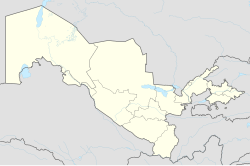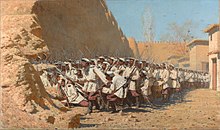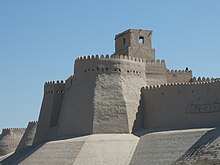Khiva
|
Khiva Chiva |
||
|
Kalta Minor in the old town of Khiva |
||
| Basic data | ||
|---|---|---|
| State : |
|
|
| Province: | Xorazm | |
| Coordinates : | 41 ° 23 ' N , 60 ° 22' E | |
|
|
||
| Height : | 98 m | |
| Residents : | 89,500 (2017) | |
| Telephone code : | (+998) 6222 | |
Xiva or Chiwa (also Khiva , Cyrillic Хива) is an oasis city in Uzbekistan with numerous testimonies of the past. Ichan Qalʼа , the historic city center of Khiva, was added to the UNESCO World Heritage List in 1990.
geography
Khiva is in the province of Xorazm (Khorezmia). It is an independent city and also the capital of a district of the same name . The city is located west of the Amu Darya on the old Silk Road .
The city has 89,500 inhabitants (as of January 1, 2017).
history
Historically, the city has always been of strategic importance due to its location on the route connecting India and Europe . Founded in the 6th century AD, Khiva 712 was conquered by Arab forces in the course of the Islamic expansion , which led to the spread of Islam .
In the 10th century, Khiva was already an important trading town in Khorezm . The Arab traveler and geographer al-Maqdisī , who toured the country in the same century, wrote: “Khiva is on the edge of the desert. It is a big city with an important Friday mosque ”.
In 1220 the armies of Genghis Khan and in 1388 those of Timur Lenk conquered the city. It was not until the beginning of the 17th century that the city of Khiva became the capital of Khiva Khanate , founded in Khoresmia in 1511 , the successor state to the old historical empire of Khorezm.
The city's fortifications were often destroyed during the frequent sieges. The last time this happened in 1740, when Khiva was conquered by the Persian Shah Nadir and the khanate was part of the Persian Empire for a short time.
Due to the discovery of gold on the Oxus bank in the reign of Peter I of Russia (1682-1725), an armed 4,000-strong trade expedition to the area began under the leadership of Prince Alexander Bekowitsch-Cherkassky . When they reached Khiva, the Khan allowed them to enter the city with alleged peaceful intent, but ambushed them. With the exception of a few survivors, the entire expedition including Prince Bekowitsch-Cherkassky was destroyed. Peter the Great, who was involved in wars with the Ottoman Empire and Sweden , did nothing.
Tsar Paul I of Russia also made an attempt to conquer the city, but failed and had to withdraw. Tsar Alexander I let the city rest, Tsars Alexander II and Alexander III. made again various attempts at conquest.
Finally, in 1873, Khiva was captured by Russian troops . From 1920 to 1925 Khiva was the capital of the People's Republic of Khorezmia . Subsequently, the city was part of the Uzbek Soviet Socialist Republic within the Soviet Union , since 1991 it has belonged to the sovereign state of Uzbekistan. In 1997, Uzbekistan celebrated the 2500th anniversary of the city of Khiva.
economy
The city has a textile industry (including carpets). Tourism plays a significant role.
Infrastructure
After Khiva , a branch line branches off to the west of Urganch station , which is on the Makat – Farap railway line . A new train station for passenger traffic was opened in Xiva in 2019 .
Attractions
Worth seeing are the numerous monuments from the glorious past of the city, especially the palace Tash Hauli , a masterpiece of Khwarazmian architecture , the impressive fortress Konya Ark and the memorial Pahlawan Mahmud . The Kalta Minor minaret was built in 1852 and was supposed to be the highest in the Islamic world at over 70 m, but it did not rise above 26 m.
Xiva has been a museum city since 1967, and the old town of Ichan Qalʼа has been under UNESCO protection since 1990, making it a World Heritage Site . Historical buildings in the old town and thus part of the world heritage are:
- Itchan-Kalas city fortifications , the city wall that surrounds almost the entire old town and the four city gates
- Konya Ark , citadel in the west of the old town
- Tasch Hauli , palace of the Khan in the east
- Memorial Pahlawan Mahmud with the holy tomb of Pahlawan Mahmund and the necropolis of the Khans of Khiva
- Said Ala ad-Din mausoleum
- Juma Mosque , Friday or Great Mosque in the center
- Ak Mosque , also known as the White Mosque in the east
- Kalta Minor , unfinished minaret with blue ceramic tiles
- Minaret of the Juma Mosque
- Islam Khodja minaret
- various madrasas
- Said Scheliker Bei complex directly in front of the old town consisting of a mosque, medrese and minaret
- Anush Khan bath house next to the Ak Mosque
- Tim , traders' passage in the east of the old town
Personalities
- Muhammad ibn Musa al-Chwarizmi , mathematician , astronomer and geographer to whom the term algorithm goes back.
- Abū 'r-Raiḥān Muḥammad ibn Aḥmad al-Bīrūnī (973-1048), natural scientist, geographer, astronomer, historian.
- Pahlawan Mahmud (1247–1326), wrestler, poet-philosopher and Sufi teacher, venerated as a saint
- Said Muhammad Rahim II , 1863 to 1910 Khan of Khiva
See also
literature
- Yuri Bregel: An Historical Atlas of Central Asia . Brill, Leiden 2003, ISBN 90-04-12321-0 , pp. 84 f. with panel 42 City map of Khiva in the 19th century.
- Vámbéry, Hermann: I was called Reschid Efendi. Travels in Central Asia, Leipzig 1990
Web links
- The architectural monuments of Khiva with photo galleries (by Bernhard Peter)
- The old town of Itchan Kala on the UNESCO World Heritage Center website ( English and French ).
- Photographic walk through Xiva EnglishRussia.com





